Teenage Pregnancy Among Indigenous and Aboriginal People
VerifiedAdded on 2023/03/17
|11
|2902
|42
AI Summary
This essay discusses the social determinants and interventions for teenage pregnancy among Indigenous and Aboriginal females.
Contribute Materials
Your contribution can guide someone’s learning journey. Share your
documents today.
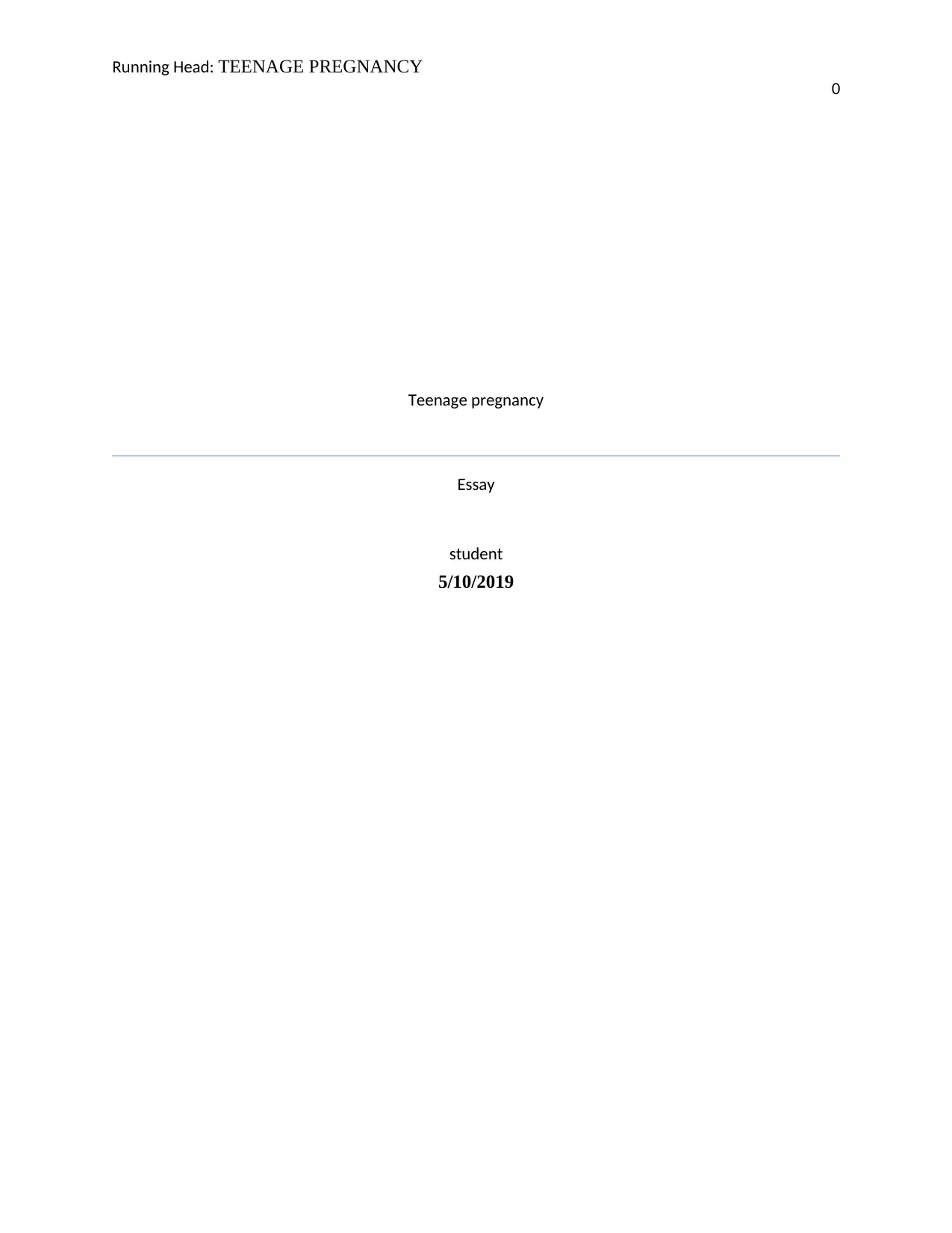
Running Head: TEENAGE PREGNANCY
0
Teenage pregnancy
Essay
student
5/10/2019
0
Teenage pregnancy
Essay
student
5/10/2019
Secure Best Marks with AI Grader
Need help grading? Try our AI Grader for instant feedback on your assignments.
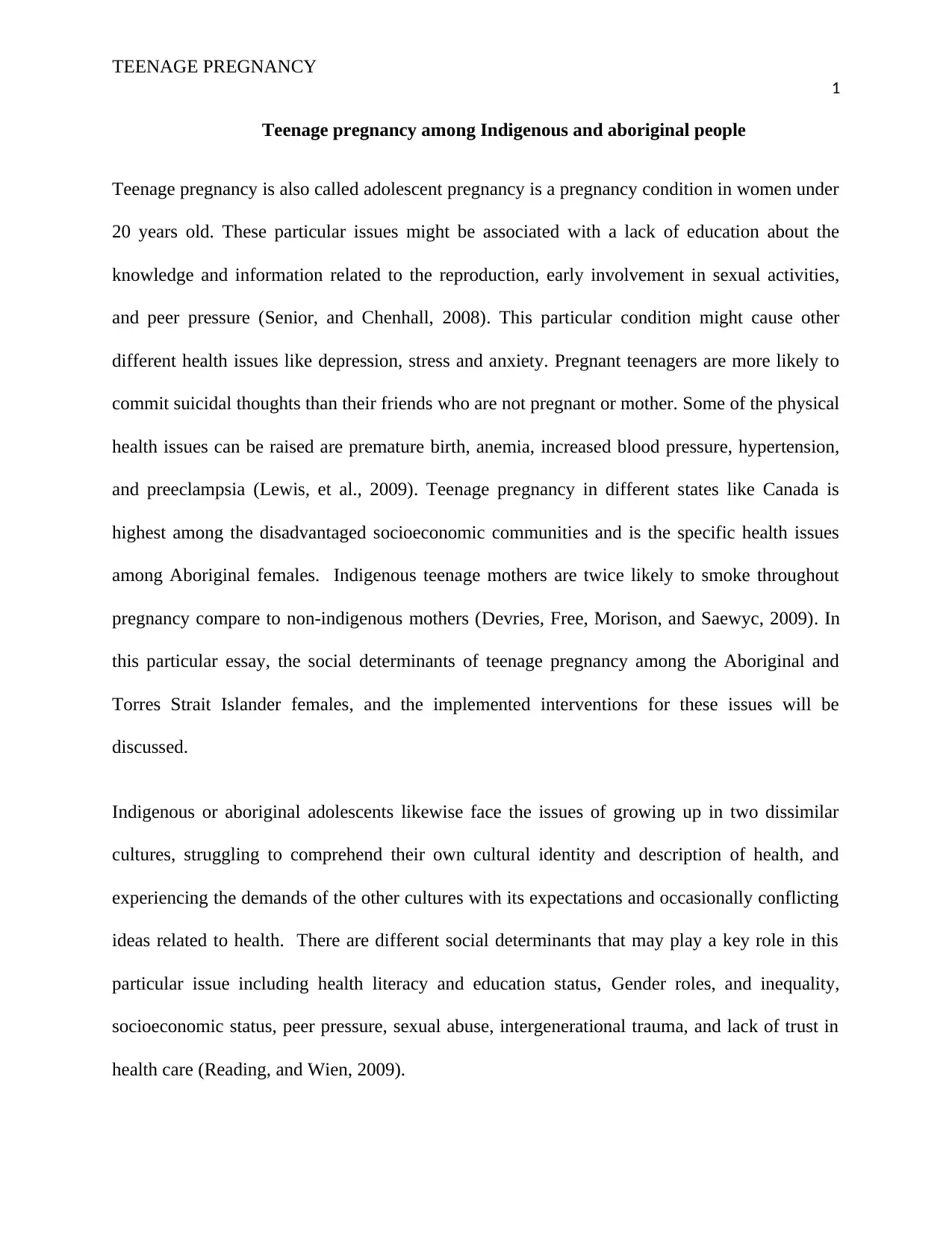
TEENAGE PREGNANCY
1
Teenage pregnancy among Indigenous and aboriginal people
Teenage pregnancy is also called adolescent pregnancy is a pregnancy condition in women under
20 years old. These particular issues might be associated with a lack of education about the
knowledge and information related to the reproduction, early involvement in sexual activities,
and peer pressure (Senior, and Chenhall, 2008). This particular condition might cause other
different health issues like depression, stress and anxiety. Pregnant teenagers are more likely to
commit suicidal thoughts than their friends who are not pregnant or mother. Some of the physical
health issues can be raised are premature birth, anemia, increased blood pressure, hypertension,
and preeclampsia (Lewis, et al., 2009). Teenage pregnancy in different states like Canada is
highest among the disadvantaged socioeconomic communities and is the specific health issues
among Aboriginal females. Indigenous teenage mothers are twice likely to smoke throughout
pregnancy compare to non-indigenous mothers (Devries, Free, Morison, and Saewyc, 2009). In
this particular essay, the social determinants of teenage pregnancy among the Aboriginal and
Torres Strait Islander females, and the implemented interventions for these issues will be
discussed.
Indigenous or aboriginal adolescents likewise face the issues of growing up in two dissimilar
cultures, struggling to comprehend their own cultural identity and description of health, and
experiencing the demands of the other cultures with its expectations and occasionally conflicting
ideas related to health. There are different social determinants that may play a key role in this
particular issue including health literacy and education status, Gender roles, and inequality,
socioeconomic status, peer pressure, sexual abuse, intergenerational trauma, and lack of trust in
health care (Reading, and Wien, 2009).
1
Teenage pregnancy among Indigenous and aboriginal people
Teenage pregnancy is also called adolescent pregnancy is a pregnancy condition in women under
20 years old. These particular issues might be associated with a lack of education about the
knowledge and information related to the reproduction, early involvement in sexual activities,
and peer pressure (Senior, and Chenhall, 2008). This particular condition might cause other
different health issues like depression, stress and anxiety. Pregnant teenagers are more likely to
commit suicidal thoughts than their friends who are not pregnant or mother. Some of the physical
health issues can be raised are premature birth, anemia, increased blood pressure, hypertension,
and preeclampsia (Lewis, et al., 2009). Teenage pregnancy in different states like Canada is
highest among the disadvantaged socioeconomic communities and is the specific health issues
among Aboriginal females. Indigenous teenage mothers are twice likely to smoke throughout
pregnancy compare to non-indigenous mothers (Devries, Free, Morison, and Saewyc, 2009). In
this particular essay, the social determinants of teenage pregnancy among the Aboriginal and
Torres Strait Islander females, and the implemented interventions for these issues will be
discussed.
Indigenous or aboriginal adolescents likewise face the issues of growing up in two dissimilar
cultures, struggling to comprehend their own cultural identity and description of health, and
experiencing the demands of the other cultures with its expectations and occasionally conflicting
ideas related to health. There are different social determinants that may play a key role in this
particular issue including health literacy and education status, Gender roles, and inequality,
socioeconomic status, peer pressure, sexual abuse, intergenerational trauma, and lack of trust in
health care (Reading, and Wien, 2009).
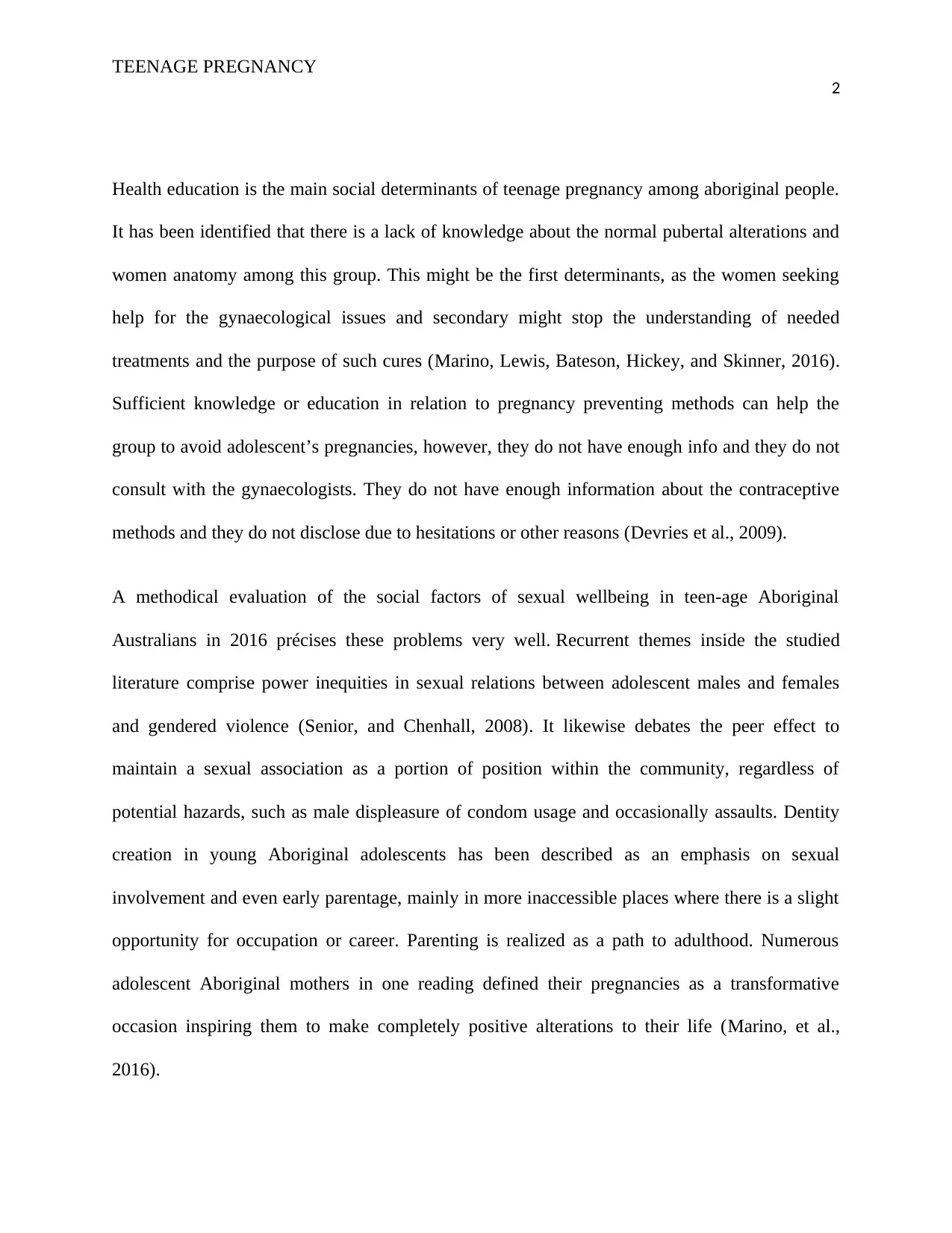
TEENAGE PREGNANCY
2
Health education is the main social determinants of teenage pregnancy among aboriginal people.
It has been identified that there is a lack of knowledge about the normal pubertal alterations and
women anatomy among this group. This might be the first determinants, as the women seeking
help for the gynaecological issues and secondary might stop the understanding of needed
treatments and the purpose of such cures (Marino, Lewis, Bateson, Hickey, and Skinner, 2016).
Sufficient knowledge or education in relation to pregnancy preventing methods can help the
group to avoid adolescent’s pregnancies, however, they do not have enough info and they do not
consult with the gynaecologists. They do not have enough information about the contraceptive
methods and they do not disclose due to hesitations or other reasons (Devries et al., 2009).
A methodical evaluation of the social factors of sexual wellbeing in teen-age Aboriginal
Australians in 2016 précises these problems very well. Recurrent themes inside the studied
literature comprise power inequities in sexual relations between adolescent males and females
and gendered violence (Senior, and Chenhall, 2008). It likewise debates the peer effect to
maintain a sexual association as a portion of position within the community, regardless of
potential hazards, such as male displeasure of condom usage and occasionally assaults. Dentity
creation in young Aboriginal adolescents has been described as an emphasis on sexual
involvement and even early parentage, mainly in more inaccessible places where there is a slight
opportunity for occupation or career. Parenting is realized as a path to adulthood. Numerous
adolescent Aboriginal mothers in one reading defined their pregnancies as a transformative
occasion inspiring them to make completely positive alterations to their life (Marino, et al.,
2016).
2
Health education is the main social determinants of teenage pregnancy among aboriginal people.
It has been identified that there is a lack of knowledge about the normal pubertal alterations and
women anatomy among this group. This might be the first determinants, as the women seeking
help for the gynaecological issues and secondary might stop the understanding of needed
treatments and the purpose of such cures (Marino, Lewis, Bateson, Hickey, and Skinner, 2016).
Sufficient knowledge or education in relation to pregnancy preventing methods can help the
group to avoid adolescent’s pregnancies, however, they do not have enough info and they do not
consult with the gynaecologists. They do not have enough information about the contraceptive
methods and they do not disclose due to hesitations or other reasons (Devries et al., 2009).
A methodical evaluation of the social factors of sexual wellbeing in teen-age Aboriginal
Australians in 2016 précises these problems very well. Recurrent themes inside the studied
literature comprise power inequities in sexual relations between adolescent males and females
and gendered violence (Senior, and Chenhall, 2008). It likewise debates the peer effect to
maintain a sexual association as a portion of position within the community, regardless of
potential hazards, such as male displeasure of condom usage and occasionally assaults. Dentity
creation in young Aboriginal adolescents has been described as an emphasis on sexual
involvement and even early parentage, mainly in more inaccessible places where there is a slight
opportunity for occupation or career. Parenting is realized as a path to adulthood. Numerous
adolescent Aboriginal mothers in one reading defined their pregnancies as a transformative
occasion inspiring them to make completely positive alterations to their life (Marino, et al.,
2016).

TEENAGE PREGNANCY
3
females with advanced levels of socioeconomic assets and social wealth have been revealed to
have improved pre-pregnancy wellbeing, better access to and usage of wellbeing facilities,
improved access to nourishing foods throughout pregnancy, additional social care and enhanced
housing, and to experience less income-related pressure. Teenage motherhood happens more
frequently within societies where poverty, Aboriginal and Torres Strait Islander position and
rural/remote place interconnect (Burbank, Senior, and McMullen, 2015). Teenage pregnancy has
been characteristically linked to a variety of opposing outcomes for women and the infant.
Specifically, In Australia, the amount of births amongst teenage women is greater among
Aboriginal and Torres Strait Islander females than amongst non-Indigenous females and the
threat of poorer mental and medical outcomes is superior if these females are not fine supported
throughout pregnancy and outside. Though, reading in the NT proposes that difficulties usually
linked with Aboriginal teenage births (like low birth weight) are not because of maternal age but
are connected to the fundamental poor wellbeing, socioeconomic drawback and a scheme that is
confronted to provision these young females, both socially and medically. Amplified rates of
teenage pregnancy and single motherhood accord with the rising feminization of poverty, chiefly
for teenage women living off standby. Current medicinal reports have emphasized the linking
between wellbeing status and socioeconomic difficulty, recognizing the "teenage girl face of
poverty" as the public wellbeing concern. As a consequence, such circumstances have given
increase to abandonment, substance abuse, and the disagreement of family relations. These
realism feed into the reasons for adolescent pregnancy, which comprise emotional requirements,
risk-taking nature, and lack of self-confidence (Fonda, Eni, and Guimond, 2013).
Sexual abuse of indigenous teenage women is another reason for adolescents’ pregnancy in
different countries like Australia, Canada, New Zealand and the US. It has been identified that
3
females with advanced levels of socioeconomic assets and social wealth have been revealed to
have improved pre-pregnancy wellbeing, better access to and usage of wellbeing facilities,
improved access to nourishing foods throughout pregnancy, additional social care and enhanced
housing, and to experience less income-related pressure. Teenage motherhood happens more
frequently within societies where poverty, Aboriginal and Torres Strait Islander position and
rural/remote place interconnect (Burbank, Senior, and McMullen, 2015). Teenage pregnancy has
been characteristically linked to a variety of opposing outcomes for women and the infant.
Specifically, In Australia, the amount of births amongst teenage women is greater among
Aboriginal and Torres Strait Islander females than amongst non-Indigenous females and the
threat of poorer mental and medical outcomes is superior if these females are not fine supported
throughout pregnancy and outside. Though, reading in the NT proposes that difficulties usually
linked with Aboriginal teenage births (like low birth weight) are not because of maternal age but
are connected to the fundamental poor wellbeing, socioeconomic drawback and a scheme that is
confronted to provision these young females, both socially and medically. Amplified rates of
teenage pregnancy and single motherhood accord with the rising feminization of poverty, chiefly
for teenage women living off standby. Current medicinal reports have emphasized the linking
between wellbeing status and socioeconomic difficulty, recognizing the "teenage girl face of
poverty" as the public wellbeing concern. As a consequence, such circumstances have given
increase to abandonment, substance abuse, and the disagreement of family relations. These
realism feed into the reasons for adolescent pregnancy, which comprise emotional requirements,
risk-taking nature, and lack of self-confidence (Fonda, Eni, and Guimond, 2013).
Sexual abuse of indigenous teenage women is another reason for adolescents’ pregnancy in
different countries like Australia, Canada, New Zealand and the US. It has been identified that
Secure Best Marks with AI Grader
Need help grading? Try our AI Grader for instant feedback on your assignments.
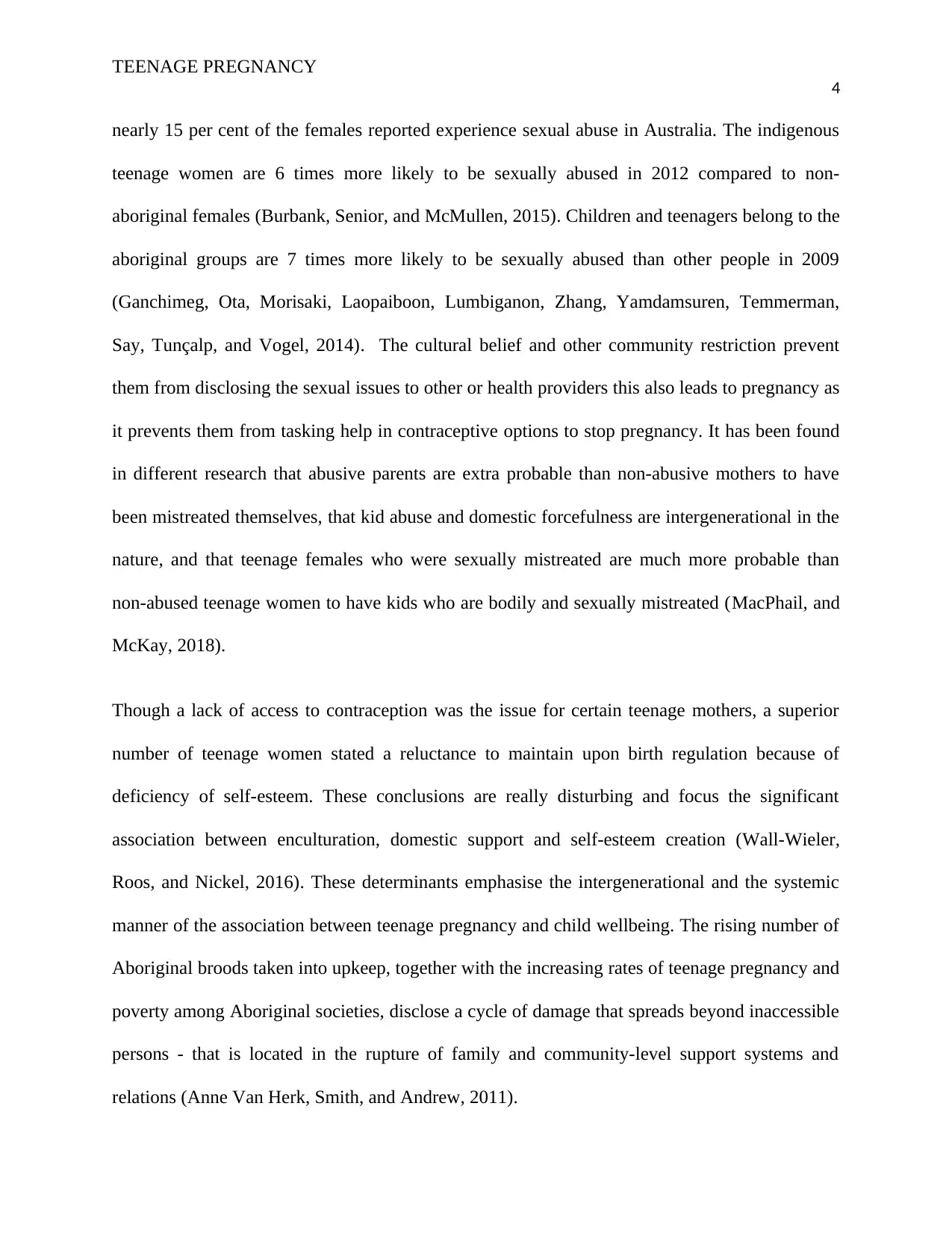
TEENAGE PREGNANCY
4
nearly 15 per cent of the females reported experience sexual abuse in Australia. The indigenous
teenage women are 6 times more likely to be sexually abused in 2012 compared to non-
aboriginal females (Burbank, Senior, and McMullen, 2015). Children and teenagers belong to the
aboriginal groups are 7 times more likely to be sexually abused than other people in 2009
(Ganchimeg, Ota, Morisaki, Laopaiboon, Lumbiganon, Zhang, Yamdamsuren, Temmerman,
Say, Tunçalp, and Vogel, 2014). The cultural belief and other community restriction prevent
them from disclosing the sexual issues to other or health providers this also leads to pregnancy as
it prevents them from tasking help in contraceptive options to stop pregnancy. It has been found
in different research that abusive parents are extra probable than non-abusive mothers to have
been mistreated themselves, that kid abuse and domestic forcefulness are intergenerational in the
nature, and that teenage females who were sexually mistreated are much more probable than
non-abused teenage women to have kids who are bodily and sexually mistreated (MacPhail, and
McKay, 2018).
Though a lack of access to contraception was the issue for certain teenage mothers, a superior
number of teenage women stated a reluctance to maintain upon birth regulation because of
deficiency of self-esteem. These conclusions are really disturbing and focus the significant
association between enculturation, domestic support and self-esteem creation (Wall-Wieler,
Roos, and Nickel, 2016). These determinants emphasise the intergenerational and the systemic
manner of the association between teenage pregnancy and child wellbeing. The rising number of
Aboriginal broods taken into upkeep, together with the increasing rates of teenage pregnancy and
poverty among Aboriginal societies, disclose a cycle of damage that spreads beyond inaccessible
persons - that is located in the rupture of family and community-level support systems and
relations (Anne Van Herk, Smith, and Andrew, 2011).
4
nearly 15 per cent of the females reported experience sexual abuse in Australia. The indigenous
teenage women are 6 times more likely to be sexually abused in 2012 compared to non-
aboriginal females (Burbank, Senior, and McMullen, 2015). Children and teenagers belong to the
aboriginal groups are 7 times more likely to be sexually abused than other people in 2009
(Ganchimeg, Ota, Morisaki, Laopaiboon, Lumbiganon, Zhang, Yamdamsuren, Temmerman,
Say, Tunçalp, and Vogel, 2014). The cultural belief and other community restriction prevent
them from disclosing the sexual issues to other or health providers this also leads to pregnancy as
it prevents them from tasking help in contraceptive options to stop pregnancy. It has been found
in different research that abusive parents are extra probable than non-abusive mothers to have
been mistreated themselves, that kid abuse and domestic forcefulness are intergenerational in the
nature, and that teenage females who were sexually mistreated are much more probable than
non-abused teenage women to have kids who are bodily and sexually mistreated (MacPhail, and
McKay, 2018).
Though a lack of access to contraception was the issue for certain teenage mothers, a superior
number of teenage women stated a reluctance to maintain upon birth regulation because of
deficiency of self-esteem. These conclusions are really disturbing and focus the significant
association between enculturation, domestic support and self-esteem creation (Wall-Wieler,
Roos, and Nickel, 2016). These determinants emphasise the intergenerational and the systemic
manner of the association between teenage pregnancy and child wellbeing. The rising number of
Aboriginal broods taken into upkeep, together with the increasing rates of teenage pregnancy and
poverty among Aboriginal societies, disclose a cycle of damage that spreads beyond inaccessible
persons - that is located in the rupture of family and community-level support systems and
relations (Anne Van Herk, Smith, and Andrew, 2011).

TEENAGE PREGNANCY
5
There is an unintended indication that, in certain settings, Aboriginal and Torres Strait Islander
females have less chance to make choices about their upkeep than non-Indigenous females, or
rarer than is wanted (Ganchimeg et al., 2014). This might be enhanced through delivering
information to teenage girls and their partners in a socially suitable manner and providing
approaches to support them attain positive alteration and by functioning in partnership with the
Aboriginal health specialists, women and societies (Azzopardi, Sawyer, Carlin, Degenhardt,
Brown, Brown, and Patton, 2018).
As discussed above lack of education is the main issues that led to the teenage pregnancy among
aboriginal people, providing education or information can be a favourable movement. Women
can be educated about the consequences of teenage pregnancy (Azzopardi, et al., 2018). The
community nurse and social workers can educate the community to use contraception and
condoms while having sex. Although there are different programmes and services already being
provided to those people by the government and nongovernment organisations. The educations
related to teenage pregnancy can be provided in school and institutes. To spread the education or
information the local aboriginal or indigenous can be included in the programs as they are more
familiar with the situation. Some of the programs already implemented are aboriginal maternity
group practice program, aboriginal family birthing programs, and aboriginal maternal and infant
health service (Rasmussen, 2015).
The socioeconomic status is one of the main factors of teenage pregnancy; this can be eliminated
by empowering aboriginal people and providing employment to them. The health care costs must
be reduced for this community (Anne Van Herk, Smith, and Andrew, 2011). The health provider
belongs to the aboriginal community should be included in the programs as it will help the
5
There is an unintended indication that, in certain settings, Aboriginal and Torres Strait Islander
females have less chance to make choices about their upkeep than non-Indigenous females, or
rarer than is wanted (Ganchimeg et al., 2014). This might be enhanced through delivering
information to teenage girls and their partners in a socially suitable manner and providing
approaches to support them attain positive alteration and by functioning in partnership with the
Aboriginal health specialists, women and societies (Azzopardi, Sawyer, Carlin, Degenhardt,
Brown, Brown, and Patton, 2018).
As discussed above lack of education is the main issues that led to the teenage pregnancy among
aboriginal people, providing education or information can be a favourable movement. Women
can be educated about the consequences of teenage pregnancy (Azzopardi, et al., 2018). The
community nurse and social workers can educate the community to use contraception and
condoms while having sex. Although there are different programmes and services already being
provided to those people by the government and nongovernment organisations. The educations
related to teenage pregnancy can be provided in school and institutes. To spread the education or
information the local aboriginal or indigenous can be included in the programs as they are more
familiar with the situation. Some of the programs already implemented are aboriginal maternity
group practice program, aboriginal family birthing programs, and aboriginal maternal and infant
health service (Rasmussen, 2015).
The socioeconomic status is one of the main factors of teenage pregnancy; this can be eliminated
by empowering aboriginal people and providing employment to them. The health care costs must
be reduced for this community (Anne Van Herk, Smith, and Andrew, 2011). The health provider
belongs to the aboriginal community should be included in the programs as it will help the

TEENAGE PREGNANCY
6
teenage girls to access the health services more easily and without hesitations. There are different
financial sources are being provided to these people in countries like Australia, New Zealand,
and Canada etc. (Al-Sahab, et al., 2012)
As teenage sexual abuse among Aboriginal people has been the topmost factor or determinants
of teenage pregnancy the government bodies must take strict actions against the offenders and
should make policies that must be followed and overlooked regularly by government officials.
After the long struggle for their rights, aboriginal people are getting enough support from
different organisations. Their rights and safety are paramount in many countries including
Australia, New Zealand, Canada, and the US. Some of the acts like Anti-discrimination act 1886
are implemented or imposed in order to reduce the sexual abuse against the people belongs to the
Aboriginal group (Buckskin, Kit, Glover, Mitchell, Miller, Weetra, Wiebe, Yelland, Newbury,
Robinson, and Brown, 2013).
Maternity and Community Health facilities, in all societies and regions, work collectively with
native health providers, the Department of Education and other important departments and
groups, to progress and deliver socially suitable school and community grounded sexual,
generative and pregnancy care wellbeing education and wellbeing promotion actions (Clarke,
and Boyle, 2014). Panyappi is the Indigenous adolescence mentoring facility for internal city
areas or suburban teenagers who experience manifold problems and are at higher risk of being a
victim of misconduct or engaging in criminal behaviour. The program targets to intervene in the
growth of criminal behaviour by educating participants’ outlooks, self-knowledge and strength of
mind (Buckskin et al., 2013).
6
teenage girls to access the health services more easily and without hesitations. There are different
financial sources are being provided to these people in countries like Australia, New Zealand,
and Canada etc. (Al-Sahab, et al., 2012)
As teenage sexual abuse among Aboriginal people has been the topmost factor or determinants
of teenage pregnancy the government bodies must take strict actions against the offenders and
should make policies that must be followed and overlooked regularly by government officials.
After the long struggle for their rights, aboriginal people are getting enough support from
different organisations. Their rights and safety are paramount in many countries including
Australia, New Zealand, Canada, and the US. Some of the acts like Anti-discrimination act 1886
are implemented or imposed in order to reduce the sexual abuse against the people belongs to the
Aboriginal group (Buckskin, Kit, Glover, Mitchell, Miller, Weetra, Wiebe, Yelland, Newbury,
Robinson, and Brown, 2013).
Maternity and Community Health facilities, in all societies and regions, work collectively with
native health providers, the Department of Education and other important departments and
groups, to progress and deliver socially suitable school and community grounded sexual,
generative and pregnancy care wellbeing education and wellbeing promotion actions (Clarke,
and Boyle, 2014). Panyappi is the Indigenous adolescence mentoring facility for internal city
areas or suburban teenagers who experience manifold problems and are at higher risk of being a
victim of misconduct or engaging in criminal behaviour. The program targets to intervene in the
growth of criminal behaviour by educating participants’ outlooks, self-knowledge and strength of
mind (Buckskin et al., 2013).
Paraphrase This Document
Need a fresh take? Get an instant paraphrase of this document with our AI Paraphraser
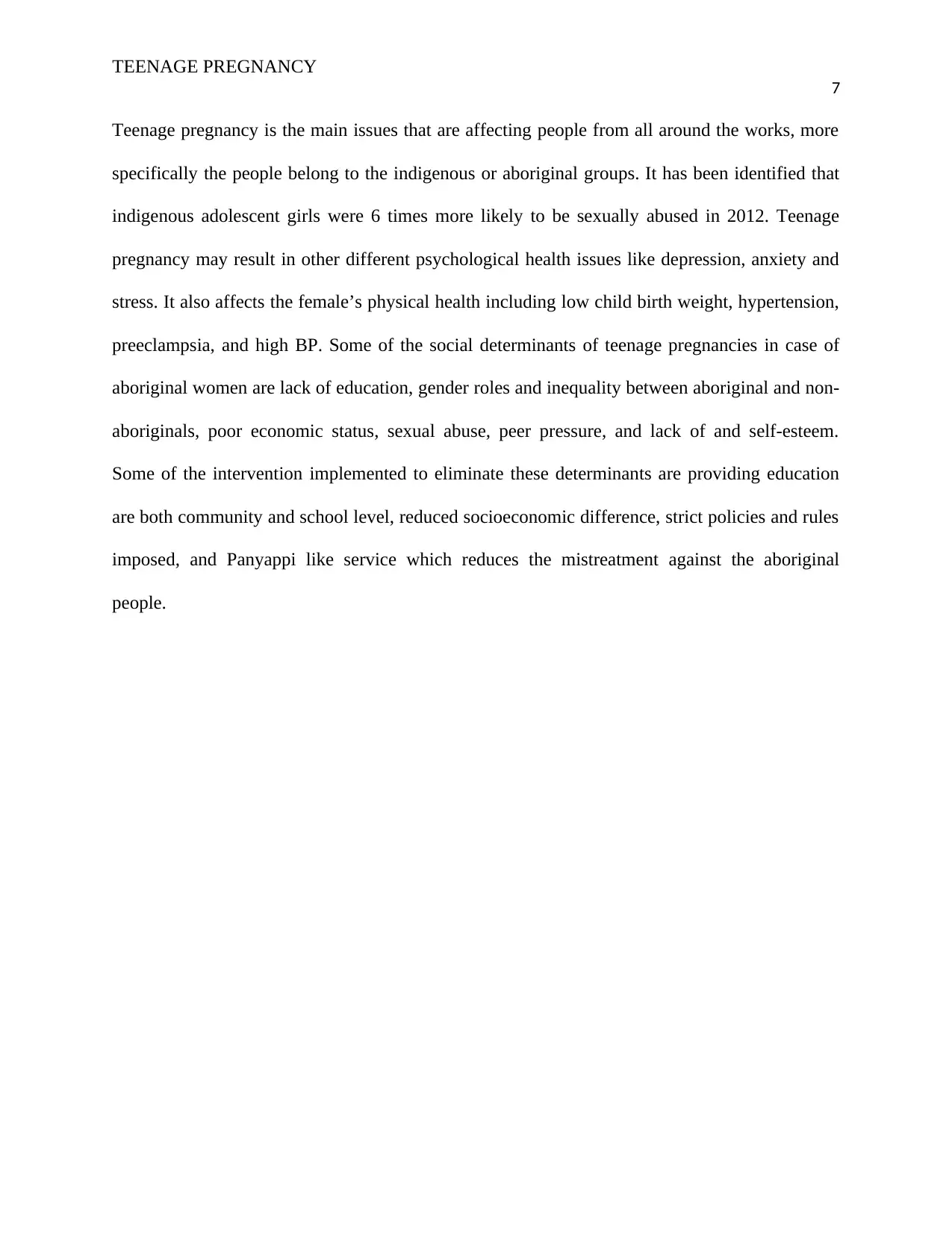
TEENAGE PREGNANCY
7
Teenage pregnancy is the main issues that are affecting people from all around the works, more
specifically the people belong to the indigenous or aboriginal groups. It has been identified that
indigenous adolescent girls were 6 times more likely to be sexually abused in 2012. Teenage
pregnancy may result in other different psychological health issues like depression, anxiety and
stress. It also affects the female’s physical health including low child birth weight, hypertension,
preeclampsia, and high BP. Some of the social determinants of teenage pregnancies in case of
aboriginal women are lack of education, gender roles and inequality between aboriginal and non-
aboriginals, poor economic status, sexual abuse, peer pressure, and lack of and self-esteem.
Some of the intervention implemented to eliminate these determinants are providing education
are both community and school level, reduced socioeconomic difference, strict policies and rules
imposed, and Panyappi like service which reduces the mistreatment against the aboriginal
people.
7
Teenage pregnancy is the main issues that are affecting people from all around the works, more
specifically the people belong to the indigenous or aboriginal groups. It has been identified that
indigenous adolescent girls were 6 times more likely to be sexually abused in 2012. Teenage
pregnancy may result in other different psychological health issues like depression, anxiety and
stress. It also affects the female’s physical health including low child birth weight, hypertension,
preeclampsia, and high BP. Some of the social determinants of teenage pregnancies in case of
aboriginal women are lack of education, gender roles and inequality between aboriginal and non-
aboriginals, poor economic status, sexual abuse, peer pressure, and lack of and self-esteem.
Some of the intervention implemented to eliminate these determinants are providing education
are both community and school level, reduced socioeconomic difference, strict policies and rules
imposed, and Panyappi like service which reduces the mistreatment against the aboriginal
people.

TEENAGE PREGNANCY
8
References
Al-Sahab, B., Heifetz, M., Tamim, H., Bohr, Y. and Connolly, J., 2012. Prevalence and
characteristics of teen motherhood in Canada. Maternal and child health journal, 16(1), pp.228-
234.
Anne Van Herk, K., Smith, D. and Andrew, C., 2011. Identity matters: Aboriginal mothers’
experiences of accessing health care. Contemporary Nurse, 37(1), pp.57-68.
Azzopardi, P.S., Sawyer, S.M., Carlin, J.B., Degenhardt, L., Brown, N., Brown, A.D. and Patton,
G.C., 2018. Health and wellbeing of Indigenous adolescents in Australia: a systematic synthesis
of population data. The Lancet, 391(10122), pp.766-782.
Buckskin, M., Kit, J.A., Glover, K., Mitchell, A., Miller, R., Weetra, D., Wiebe, J., Yelland, J.S.,
Newbury, J., Robinson, J. and Brown, S.J., 2013. Aboriginal Families Study: a population-based
study keeping community and policy goals in mind right from the start. International journal for
equity in health, 12(1), p.41.
Burbank, V., Senior, K. and McMullen, S., 2015. Precocious pregnancy, sexual conflict, and
early childbearing in remote Aboriginal Australia. In Anthropological Forum (Vol. 25, No. 3, pp.
243-261). Routledge.
Clarke, M. and Boyle, J., 2014. Antenatal care for Aboriginal and Torres Strait Islander
women. Australian family physician, 43(1/2), p.20.
Devries, K.M., Free, C.J., Morison, L. and Saewyc, E., 2009. Factors associated with pregnancy
and STI among Aboriginal students in British Columbia. Canadian Journal of Public
Health, 100(3), pp.226-230.
8
References
Al-Sahab, B., Heifetz, M., Tamim, H., Bohr, Y. and Connolly, J., 2012. Prevalence and
characteristics of teen motherhood in Canada. Maternal and child health journal, 16(1), pp.228-
234.
Anne Van Herk, K., Smith, D. and Andrew, C., 2011. Identity matters: Aboriginal mothers’
experiences of accessing health care. Contemporary Nurse, 37(1), pp.57-68.
Azzopardi, P.S., Sawyer, S.M., Carlin, J.B., Degenhardt, L., Brown, N., Brown, A.D. and Patton,
G.C., 2018. Health and wellbeing of Indigenous adolescents in Australia: a systematic synthesis
of population data. The Lancet, 391(10122), pp.766-782.
Buckskin, M., Kit, J.A., Glover, K., Mitchell, A., Miller, R., Weetra, D., Wiebe, J., Yelland, J.S.,
Newbury, J., Robinson, J. and Brown, S.J., 2013. Aboriginal Families Study: a population-based
study keeping community and policy goals in mind right from the start. International journal for
equity in health, 12(1), p.41.
Burbank, V., Senior, K. and McMullen, S., 2015. Precocious pregnancy, sexual conflict, and
early childbearing in remote Aboriginal Australia. In Anthropological Forum (Vol. 25, No. 3, pp.
243-261). Routledge.
Clarke, M. and Boyle, J., 2014. Antenatal care for Aboriginal and Torres Strait Islander
women. Australian family physician, 43(1/2), p.20.
Devries, K.M., Free, C.J., Morison, L. and Saewyc, E., 2009. Factors associated with pregnancy
and STI among Aboriginal students in British Columbia. Canadian Journal of Public
Health, 100(3), pp.226-230.
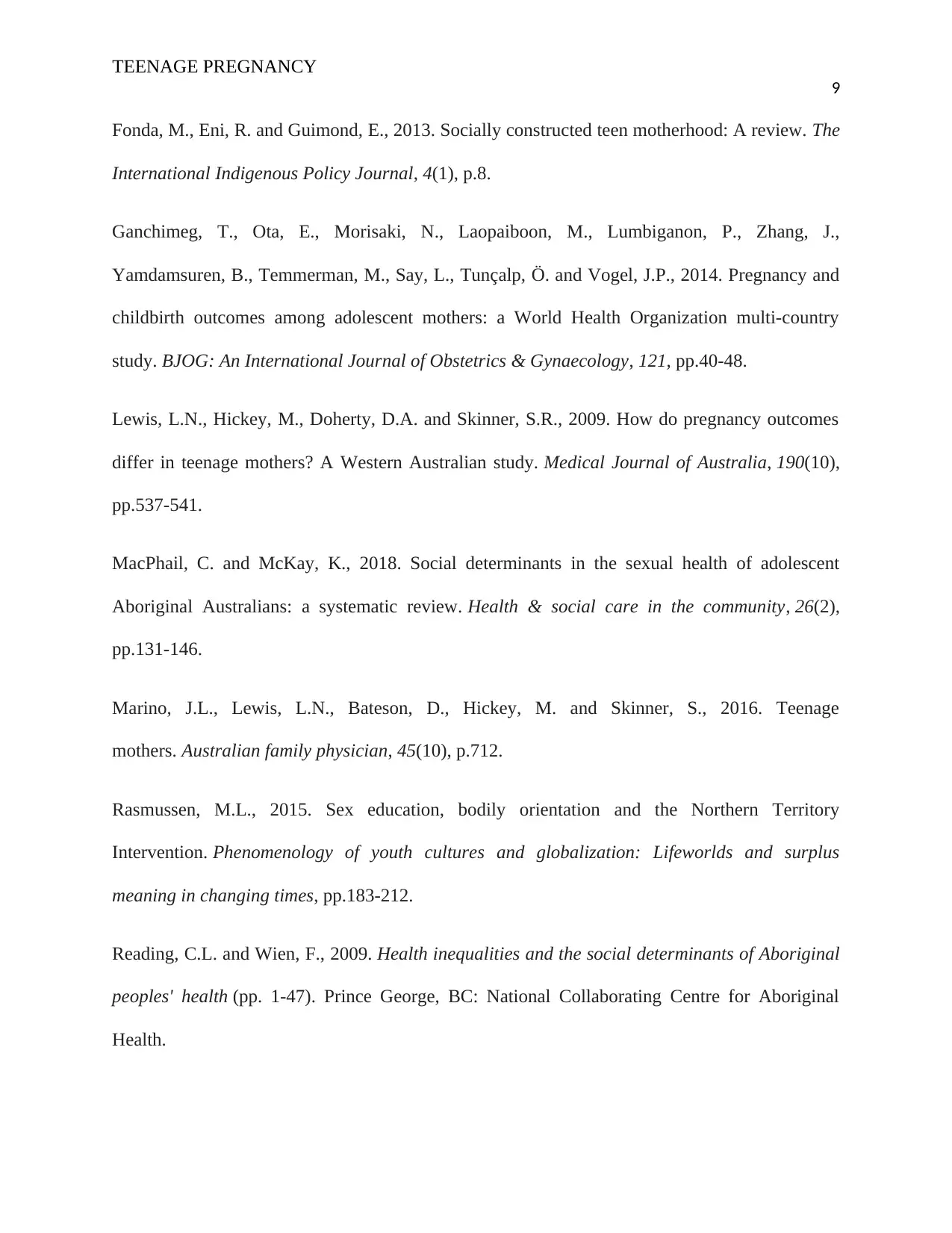
TEENAGE PREGNANCY
9
Fonda, M., Eni, R. and Guimond, E., 2013. Socially constructed teen motherhood: A review. The
International Indigenous Policy Journal, 4(1), p.8.
Ganchimeg, T., Ota, E., Morisaki, N., Laopaiboon, M., Lumbiganon, P., Zhang, J.,
Yamdamsuren, B., Temmerman, M., Say, L., Tunçalp, Ö. and Vogel, J.P., 2014. Pregnancy and
childbirth outcomes among adolescent mothers: a World Health Organization multi-country
study. BJOG: An International Journal of Obstetrics & Gynaecology, 121, pp.40-48.
Lewis, L.N., Hickey, M., Doherty, D.A. and Skinner, S.R., 2009. How do pregnancy outcomes
differ in teenage mothers? A Western Australian study. Medical Journal of Australia, 190(10),
pp.537-541.
MacPhail, C. and McKay, K., 2018. Social determinants in the sexual health of adolescent
Aboriginal Australians: a systematic review. Health & social care in the community, 26(2),
pp.131-146.
Marino, J.L., Lewis, L.N., Bateson, D., Hickey, M. and Skinner, S., 2016. Teenage
mothers. Australian family physician, 45(10), p.712.
Rasmussen, M.L., 2015. Sex education, bodily orientation and the Northern Territory
Intervention. Phenomenology of youth cultures and globalization: Lifeworlds and surplus
meaning in changing times, pp.183-212.
Reading, C.L. and Wien, F., 2009. Health inequalities and the social determinants of Aboriginal
peoples' health (pp. 1-47). Prince George, BC: National Collaborating Centre for Aboriginal
Health.
9
Fonda, M., Eni, R. and Guimond, E., 2013. Socially constructed teen motherhood: A review. The
International Indigenous Policy Journal, 4(1), p.8.
Ganchimeg, T., Ota, E., Morisaki, N., Laopaiboon, M., Lumbiganon, P., Zhang, J.,
Yamdamsuren, B., Temmerman, M., Say, L., Tunçalp, Ö. and Vogel, J.P., 2014. Pregnancy and
childbirth outcomes among adolescent mothers: a World Health Organization multi-country
study. BJOG: An International Journal of Obstetrics & Gynaecology, 121, pp.40-48.
Lewis, L.N., Hickey, M., Doherty, D.A. and Skinner, S.R., 2009. How do pregnancy outcomes
differ in teenage mothers? A Western Australian study. Medical Journal of Australia, 190(10),
pp.537-541.
MacPhail, C. and McKay, K., 2018. Social determinants in the sexual health of adolescent
Aboriginal Australians: a systematic review. Health & social care in the community, 26(2),
pp.131-146.
Marino, J.L., Lewis, L.N., Bateson, D., Hickey, M. and Skinner, S., 2016. Teenage
mothers. Australian family physician, 45(10), p.712.
Rasmussen, M.L., 2015. Sex education, bodily orientation and the Northern Territory
Intervention. Phenomenology of youth cultures and globalization: Lifeworlds and surplus
meaning in changing times, pp.183-212.
Reading, C.L. and Wien, F., 2009. Health inequalities and the social determinants of Aboriginal
peoples' health (pp. 1-47). Prince George, BC: National Collaborating Centre for Aboriginal
Health.
Secure Best Marks with AI Grader
Need help grading? Try our AI Grader for instant feedback on your assignments.
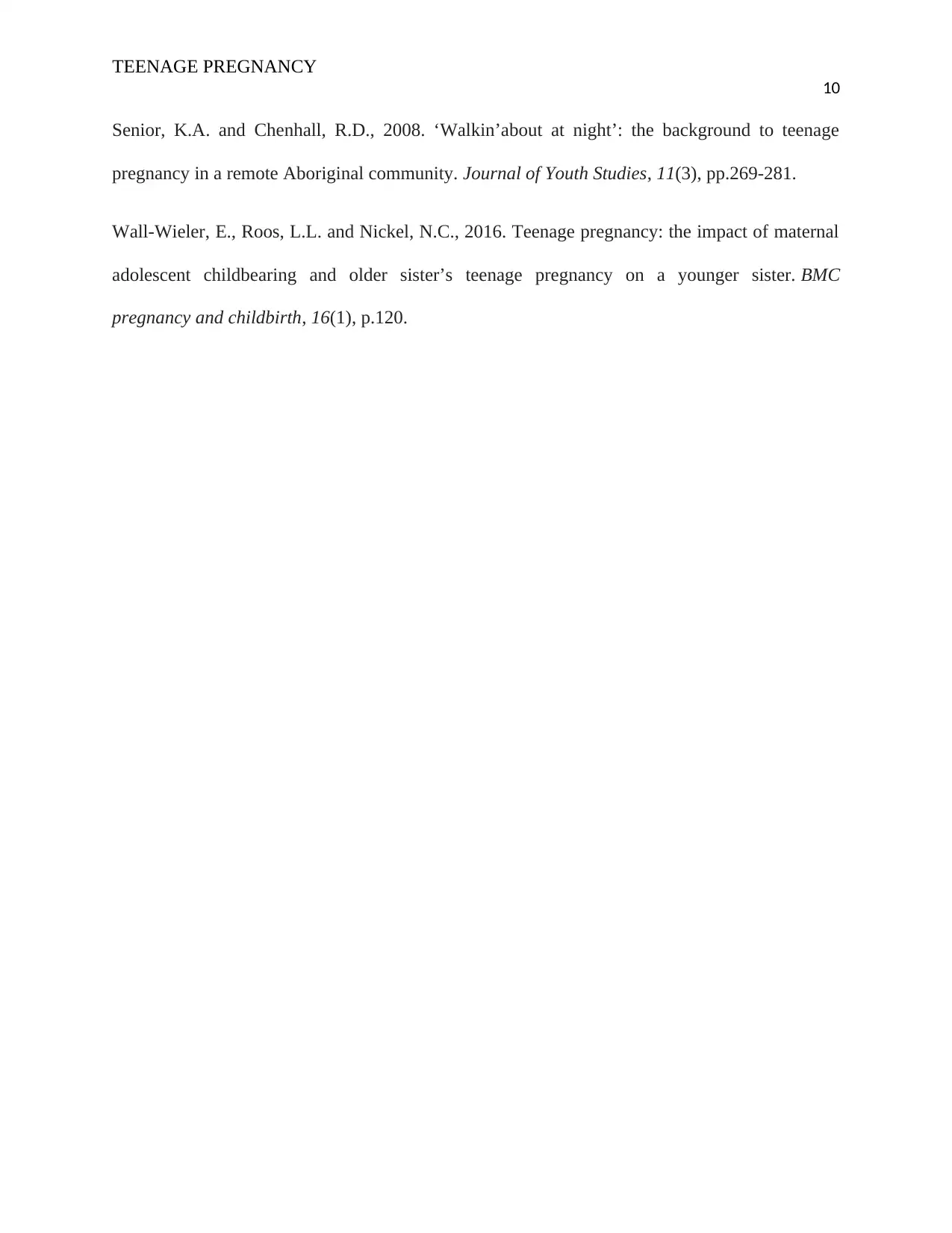
TEENAGE PREGNANCY
10
Senior, K.A. and Chenhall, R.D., 2008. ‘Walkin’about at night’: the background to teenage
pregnancy in a remote Aboriginal community. Journal of Youth Studies, 11(3), pp.269-281.
Wall-Wieler, E., Roos, L.L. and Nickel, N.C., 2016. Teenage pregnancy: the impact of maternal
adolescent childbearing and older sister’s teenage pregnancy on a younger sister. BMC
pregnancy and childbirth, 16(1), p.120.
10
Senior, K.A. and Chenhall, R.D., 2008. ‘Walkin’about at night’: the background to teenage
pregnancy in a remote Aboriginal community. Journal of Youth Studies, 11(3), pp.269-281.
Wall-Wieler, E., Roos, L.L. and Nickel, N.C., 2016. Teenage pregnancy: the impact of maternal
adolescent childbearing and older sister’s teenage pregnancy on a younger sister. BMC
pregnancy and childbirth, 16(1), p.120.
1 out of 11
Related Documents
Your All-in-One AI-Powered Toolkit for Academic Success.
+13062052269
info@desklib.com
Available 24*7 on WhatsApp / Email
![[object Object]](/_next/static/media/star-bottom.7253800d.svg)
Unlock your academic potential
© 2024 | Zucol Services PVT LTD | All rights reserved.





